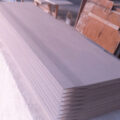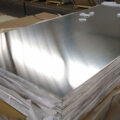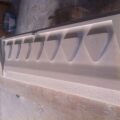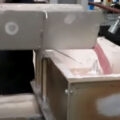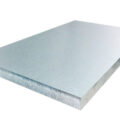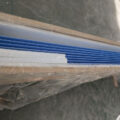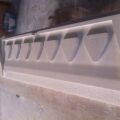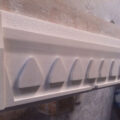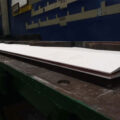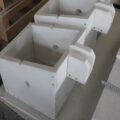In the continuous casting and rolling process of the slab, the liquid metal uses the static pressure of the liquid level of the front box to continuously deliver the liquid metal to the roll gap through the feed nozzle. When the metal melt gushes from the feed nozzle and the casting roll, the surface touches, it starts to crystallize. The gap between the ceramic fiber caster tip and the casting roll is called the nozzle roll gap.
The aluminum melt forms a very thin oxide film at the mouth nip. The oxide film is arc-shaped. Because the liquid surface is curved and open, the surface tension of the liquid surface gives a certain component to the liquid metal in the liquid cavity to ensure that the metal does not Leakage from the gap between the nozzle rollers. Similarly, the molten metal in the liquid cavity gives the oxide film a reaction force, which is the static pressure of the liquid surface of the front tank acting on the liquid surface through the transfer of the liquid. Under the interaction between the surface tension of the oxide film and the static pressure of the liquid metal in the front box, the casting-rolling process reaches equilibrium.

When the static pressure of the liquid metal in the production tank is constant, the continuous rotation of the casting roll will change the radius of the curvature of the oxide film, which will make the entire casting and rolling process in a dynamic equilibrium state. When the surface tension of the oxide film exerts an additional pressure on the melt and the former When the static pressure of the box is in equilibrium, the radius of curvature of the oxide film is the smallest. With the rotation of the casting roll, the oxide film is elongated, and the curvature between the nozzle roll gap gradually increases. As the radius of curvature of the oxide film increases, the pressure of the oxide film on the melt becomes smaller. When the hydrostatic pressure of the front box aluminum exceeds the additional pressure of the surface tension, the oxide film is destroyed, and the oxide film is restored to the state with the smallest radius of curvature. At this time, the new aluminum liquid is corroded with the cooled casting roll, and new crystal nuclei begin to form. With the continuous rotation of the casting roll mold, the curvature radius of the liquid surface oxide film continues to circulate, gradually increasing from the minimum state to In the destruction process, the balance and imbalance between the additional pressure of surface tension and the pressure of static pressure change continuously and periodically, and new liquid metal continuously contacts the casting roll to generate new crystal nuclei.
The size of the nozzle roll gap has a great influence on the product quality of the cast-rolled strip. In the process of adjusting the nozzle roll gap, the thermal expansion of the nozzle itself, the expansion when filled with molten aluminum, and the radius of curvature of the oxide film should be considered. And the melt surface tension and other factors, so that the gap between the roll and the nozzle roll can be determined according to the thickness, width and alloy type. When the gap between the nozzle roll is too small, the distance between the casting roll and the nozzle is too close, and it is easy to form slag on the nozzle, so that the aluminum slag forms a small, uneven sticky aluminum tape on the surface of the roll in the circumferential direction, and a phase is formed on the surface of the strip. Corresponding to the uneven lines along the length, this is the longitudinal stripes; when the mouth gap is too large, the oxide film will be broken, and the residual oxide will adhere to the roller and be brought into the gap between the nozzle rollers, so that the oxide film is sandwiched between the nozzle roller gap, causing local micro-compression of the casting nozzle here, causing uneven melt distribution and slag sticking, so that the solidification rate on the surface of the strip undergoes periodic changes, the dendrite spacing also produces periodic changes, and longitudinal stripes are accompanied. Therefore, reasonable adjustment of the nozzle gap plays a vital role in product quality.


